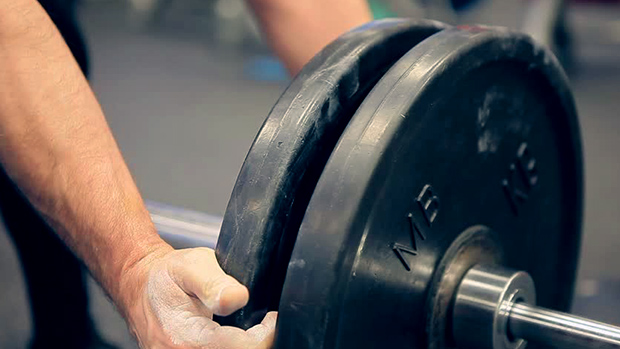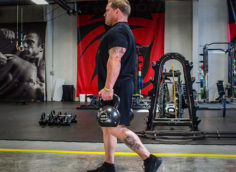Welcome to the final stage of the Growth Surge Project. If you missed Part 1, you can read it here. And, if you missed Part 2, you can read it here.
The Recovery Stage
Whew! The two weeks of intensive training and even more intensive eating are over and you can relax and recover. Well, sort of. You'll still be hitting weights during this stage and the diet regime will still require some discipline, but it'll feel easy compared to the previous stage.
While short periods of super-high levels of training intensity are awesome, you can't maintain them forever (even if you're on steer-oids). So while this may seem like heresy, those who go "balls to the walls" for months on end often don't look as good as those who use short, well-planned periods of intense training followed by a smart recovery plan.
One problem we've noticed is that while most people have the balls to dive into an intense program like the one in Stage 2, very few have the discipline to "do the right thing" after such a program. What's the right thing to do? Well, first off, you do not want to go on a strict, low calorie keto diet and do excessive cardio! If you do, then you're just asking to lose your hard-earned new muscle.
Instead you need to keep the calories up (although not as high as the previous stage), add back in a little cardio, and slowly peel off any fat you added during the Growth Surge stage. In other words, it's time to get off the roller coaster when it comes to your physique and stop fluctuating between being overly fat and overly skinny. This is part of being mentally tough: knowing when to ease back a bit and being smart enough to practice patience.
So the goals of the Recovery Stage are:
1) Retain the muscle gained from the previous stages.
2) Carefully drop any extra fat gained during the Growth Surge stage.
3)
Allow full recovery and regeneration.
Are you ready? Then let's go out with a bang in Stage 3!
Training
These two weeks should provide the opportunity to gradually cycle back into your own training routine based on your goals. Take the first three days of the Recovery Stage and stay out of the gym! This means you! For three days, just relax and eat properly as outlined below. If you want to do some "active rest" type of activity, that's fine, but don't overdo it and leave the weights alone. Hey, even the Big Guy Himself took Sunday off to watch TV and stuff.
After the three days of rest, you're going to resume a more normal, once-per-day training program with each body part trained only once per week. We're going to keep the volume moderate and avoid training to total failure. Train hard, but leave one rep "in the hole" with no strip sets, forced reps, or super slow negatives.
We're also going to alternate muscle groups, where appropriate, to ensure more recovery between sets. In other words, on chest and back day, you'll do one set of chest work, rest, do one set of back work, rest, and then start over with chest again. Leg days will remain split based on quad and hip dominant exercises, which is an Ian King protocol we really like.
Here's a suggested program for the Recovery Stage that will be appropriate for most people:
Week One
Monday:
Hip Dominant Legs and Calves
Deadlifts: 3 x 10-12 reps
Lying Leg Curls: 3 x 6-8 reps
Static Lunges*: 3 x 10-12 each leg
Standing Calf Raises: 3 x 6-8 reps
Cardio: Perform any form you like, after training, for a period of 15 minutes.
* Static lunges are performed by holding a dumbbell in each hand and stepping forward with one leg. Keeping the front foot in place, lower yourself until the knee of the back leg grazes the floor (but doesn't rest there). Come back up and repeat for 10-12 reps. Rest and then repeat with the other leg in the forward position.
Tuesday:
Chest and Back
A1) Bent Over Barbell Rows: 3 x 10-12
A2) Dumbbell Bench Press: 3 x 10-12
B1) Wide-grip Pull-ups: Perform as many reps as possible, but stop one rep short of failure. If you get over 15 reps, add weight with a dipping belt or by holding a dumbbell between your feet.
B2) Dips: same as pull-ups above
Cardio: Perform any form you like, after training, for a period of 15 minutes.
Note: Those "A1, A2" designations basically mean to do supersets, only you'll rest between sets. So do a set of rows, rest, then do a set of dumbbell bench press. Repeat for the required number of sets and then move to the "B1, B2" movements.
Wednesday: Off
Thursday:
Shoulders and Arms
A) Overhead Dumbbell Press: 3 x 10-12
B1) Standing Barbell Curls: 3 x 10-12
B2) Skull Crushers (Tricep Extensions): 3 x 10-12
C1) Incline Dumbbell Hammer Curls (palms facing each other): 3 x 10-12
C2) Rope Pressdowns: 3 x 10-12
Cardio: Perform any form you like, after training, for a period of 15 minutes.
Friday:
Quad Dominant Legs and Calves
Squats: 3 x 10-12
Leg Press (feet low and close together): 3 x 8-10
Leg Extensions: 3 x 10-12
Seated Calf Raises: 3 x 12-15
Cardio: Perform any form you like, after training, for a period of 15 minutes.
Saturday and Sunday: Off
Week Two
Same as above
Note: You may do abdominal training whenever you prefer, but if abs are a priority, we suggest you do them at the beginning of your workouts a couple of days per week.
Nutrition
Since your calorie needs will be significantly less than they were during your Growth Surge weeks, we want you to cut out the extra calories and use the regular Massive Eating calorie formula supplied below (15% fewer calories than you used in the Growth Surge stage.) This is still a hypercaloric diet, but it accommodates your drop in activity. Remember, we need to keep the calories up since you're trying to preserve the gains you made during the last two weeks! This is not the time to diet.
You may be tempted to just subtract 15% from the amount of calories you used in Stage 2, but don't forget that your body composition has now changed. So we suggest you re-calculate your calorie needs for this stage using the formula at the end of this article.
You're still going to be eating Massive Eating style during this stage and following the macronutrient combining guidelines. You should be good at that by this time.
Supplementation
• Multi-Vitamin/Multi-Mineral
• Surge – half a serving taken during each workout and half a serving taken immediately after each workout
• Tribex – 6 capsules per day
• Methoxy 7 – per label recommendations
• Biotest "M" – per label recommendations if our factory got its butt in gear and got it out in time. (If not, then consider using a stand-alone vitex product.)
• 10g of regular ol' creatine powder (taken as you did in the first two stages)
• Advanced Protein – Use as needed to meet calorie and protein requirements and fill in the gaps from regular food intake.
Tips
• Again, we encourage patience and self-control. You may want to train harder and add more sets because of the success you experienced in Stage 2, but don't. We need to step off a bit and work to "solidify" the gains you made in the previous stage. Patience is a virtue, and in this case it will help you become a buff SOB, too.
• Weigh, measure, and check your bodyfat again at the end of this stage. Then, we ask that you fill out the feedback form at the bottom of this page and let us know your results.
Now What Do I Do?
You may be wondering what you should do once you've completed all the stages, you know, besides spending all day in front of the mirror flexing. At this point there's no set recipe that we can recommend for everyone. Instead, it's time that you become the boss, the master of your own domain. Look back at your results from each of the two-week cycles and they'll tell you how you responded to each phase.
We've got some words of caution, however. Unless you've done detailed body composition measures and girth measures, your weight numbers mean very little. After all, adding a few pounds of muscle and losing a few pounds of fat doesn't show up much on the scale. You want to know how your muscle mass and fat mass changed independently, don't you? You won't know this if you dropped the ball and only went by your weight.
Anyway, based on your results, you'll know what to do next. If you responded very well to the entire program (i.e. you finished the 42 days and have packed on the weight equivalent of the body of a small marathon runner), then go ahead and give it another try. However, cycling through it indefinitely may lead to stagnation in the long run since the body basically adapts to any routine it's given. So you can keep it going until the results start to plateau; then it's time to go on a more conventional eating and training program. There are plenty of these to choose from in the Previous Issues section of T-mag.
If the program didn't produce such astounding gains in lean mass, then you should tinker around with the duration of each phase based on the results or lack thereof. Perhaps a longer duration Growth Surge (Stage 2) would be most beneficial. Or maybe your activity levels outside the gym are negating your growth potential. Figure out how to make the program work and then follow the advice above.
Finally, if you got too fat in Stage 2 of the program, perhaps you need to decrease your calories a bit for that stage. However, it's our experience that most weightlifters who claim to have a "slow metabolism" are this way because either they use poor food combinations or they have made their metabolism slow through chronic under eating. So be careful before you decide that the calorie intake is too high. Again, in this situation, find out how to make the program work for you and then see the instructions above.
Conclusion
If you've followed the program to a "T" and put some effort into your training and diet, then you're probably one happy lifter right now. If you haven't started the program yet, what are you waiting for? The entire Growth Surge lasts about 42 days. If you can't hang in there for 42 days, then you've picked the wrong hobby. Think of this as a mental and physical challenge, a test to see if you've got the discipline and drive needed to succeed.
If you pass the test, then the reward will be muscle hypertrophy, less fat, and the knowledge that you've succeeded where so many others fail. And that's a trophy you can carry with you everywhere you go.
Tools
Recovery Stage Calorie Formula (same as Massive Eating plan)
For this stage, you're going to be eating according the original Massive Eating calorie guidelines. (You may know this number already, but remember, we suggest you re-calculate because of the body composition changes you experienced in the first two stages.)
Step #1 – First, determine your resting metabolic rate or RMR. Divide your bodyweight by 2.2 to convert it into kilograms. A 180 pound guy would weigh 82 kg.
Now take your percent of bodyfat and multiply it by your weight in kilograms to get your fat mass (FM). If our 82 kg guy has 12% bodyfat, so 82 x .12 = 9.84 kg FM.
Now subtract this number from your total weight in kilograms to get your fat free mass. Our guy would subtract 9.84 kg from 82 kg to get a Fat Free Mass (FFM) of 72.16 kg.
Now multiply your FFM times 22 and add 500. That's your RMR. Our guy would multiply 22 x 72.16 to get 1587.52. Add 500 for a total of 2087.52. So his RMR is about 2087 calories per day.
Step #2 – Now we need to determine the costs of daily activity. We do this by multiplying the RMR you got above with one of the numbers below that best represents your daily activity level not counting workouts.
Activity Factors:
1.2-1.3 for Very Light (bed rest)
1.5-1.6 for Light (office work/watching TV)
1.6-1.7 for Moderate (some activity during day)
1.9-2.1 for Heavy (labor type work)
So if our sample guy worked in an office setting, he'd choose 1.5. So 2087 calories (his RMR) times 1.5 = about 3130 calories.
Step #3 – Now to figure Cost of Exercise Activity. Multiply total body mass in kilograms by duration of exercise in hours. Then multiply that number by MET value base on chart:
MET values for common activities:
high impact aerobics... 7
low impact aerobics... 5
high intensity cycling... 12
low intensity cycling... 3
high intensity walking... 6.5
low intensity walking... 2.5
high intensity running... 18
low intensity running... 7
circuit-type training... 8
intense free weight lifting... 6
moderate machine training... 3
So here's the formula:
Cost of Exercise Activity = Body Mass (in kg) x Duration (in hours) x MET value
Let's break that down using our sample dude. Let's say he trains with weights for an hour each time he hits the gym. The MET value for intense free weight lifting is 6. So he'll multiply his weight in kilograms (82kg) times one hour (1.0) times 6. So he uses about 492 calories during his weight training session.
Next, since he does 15 minutes of cardio after each weight training session, that's a MET value of 3. So he'll multiply his weight in kilograms (82) times 15 minutes (0.25) times 3. So he uses about 62 calories during cardio.
So now our guy is going to add 492 calories to his total thus far. 3130 + 492 = 3622. Then he's going to add 62 calories to this number to get 3684.
Step #4 – Now go back and look at your RMR number again. Our guy's is 2087. To calculate the thermic effect of food, you should multiply your RMR times 0.10 if you eat one gram of protein per pound of bodyweight and 0.15 if you eat over one gram of protein per pound of bodyweight. So 2087 x 0.15 = 313. Our guy would then add that number to his total. 313 + 3684 = 3997 calories. So, our sample dude would need about 4,000 calories per day.
BEFORE GROWTH SURGE
Age:
Height:
Weight:
Bodyfat %:
Other Measurements If Taken:
AFTER 6 WEEKS OF GROWTH SURGE
Weight:
Bodyfat %:
Other Measurements:
What changes did you make to the program, if any, to better fit your needs/lifestyle?
Would you use this program again?
If yes, what modifications would you make?
What was the toughest part of the program?
Did you use the supplements recommended?
If yes, which helped you the most? If you didn't use the supplements recommended, which did you use?
Any additional comments?




